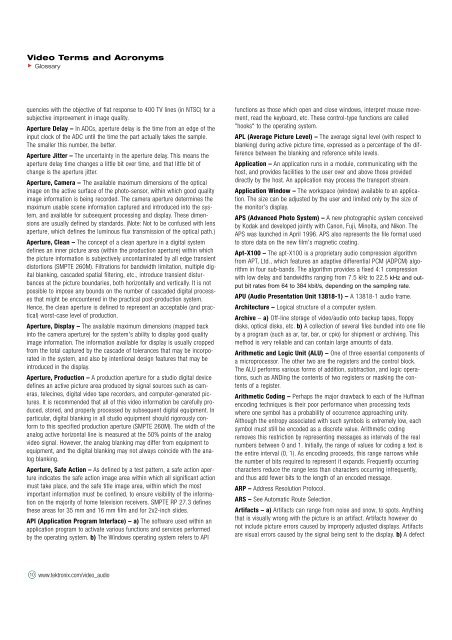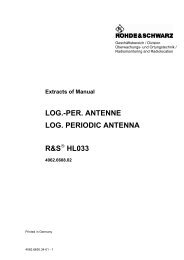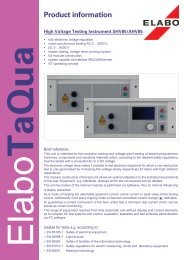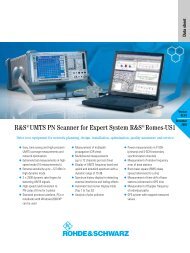Glossary of Video Terms and Acronyms - Isotest
Glossary of Video Terms and Acronyms - Isotest
Glossary of Video Terms and Acronyms - Isotest
Create successful ePaper yourself
Turn your PDF publications into a flip-book with our unique Google optimized e-Paper software.
<strong>Video</strong> <strong>Terms</strong> <strong>and</strong> <strong>Acronyms</strong><br />
<strong>Glossary</strong><br />
quencies with the objective <strong>of</strong> flat response to 400 TV lines (in NTSC) for a<br />
subjective improvement in image quality.<br />
Aperture Delay – In ADCs, aperture delay is the time from an edge <strong>of</strong> the<br />
input clock <strong>of</strong> the ADC until the time the part actually takes the sample.<br />
The smaller this number, the better.<br />
Aperture Jitter – The uncertainty in the aperture delay. This means the<br />
aperture delay time changes a little bit over time, <strong>and</strong> that little bit <strong>of</strong><br />
change is the aperture jitter.<br />
Aperture, Camera – The available maximum dimensions <strong>of</strong> the optical<br />
image on the active surface <strong>of</strong> the photo-sensor, within which good quality<br />
image information is being recorded. The camera aperture determines the<br />
maximum usable scene information captured <strong>and</strong> introduced into the system,<br />
<strong>and</strong> available for subsequent processing <strong>and</strong> display. These dimensions<br />
are usually defined by st<strong>and</strong>ards. (Note: Not to be confused with lens<br />
aperture, which defines the luminous flux transmission <strong>of</strong> the optical path.)<br />
Aperture, Clean – The concept <strong>of</strong> a clean aperture in a digital system<br />
defines an inner picture area (within the production aperture) within which<br />
the picture information is subjectively uncontaminated by all edge transient<br />
distortions (SMPTE 260M). Filtrations for b<strong>and</strong>width limitation, multiple digital<br />
blanking, cascaded spatial filtering, etc., introduce transient disturbances<br />
at the picture boundaries, both horizontally <strong>and</strong> vertically. It is not<br />
possible to impose any bounds on the number <strong>of</strong> cascaded digital processes<br />
that might be encountered in the practical post-production system.<br />
Hence, the clean aperture is defined to represent an acceptable (<strong>and</strong> practical)<br />
worst-case level <strong>of</strong> production.<br />
Aperture, Display – The available maximum dimensions (mapped back<br />
into the camera aperture) for the system's ability to display good quality<br />
image information. The information available for display is usually cropped<br />
from the total captured by the cascade <strong>of</strong> tolerances that may be incorporated<br />
in the system, <strong>and</strong> also by intentional design features that may be<br />
introduced in the display.<br />
Aperture, Production – A production aperture for a studio digital device<br />
defines an active picture area produced by signal sources such as cameras,<br />
telecines, digital video tape recorders, <strong>and</strong> computer-generated pictures.<br />
It is recommended that all <strong>of</strong> this video information be carefully produced,<br />
stored, <strong>and</strong> properly processed by subsequent digital equipment. In<br />
particular, digital blanking in all studio equipment should rigorously conform<br />
to this specified production aperture (SMPTE 260M). The width <strong>of</strong> the<br />
analog active horizontal line is measured at the 50% points <strong>of</strong> the analog<br />
video signal. However, the analog blanking may differ from equipment to<br />
equipment, <strong>and</strong> the digital blanking may not always coincide with the analog<br />
blanking.<br />
Aperture, Safe Action – As defined by a test pattern, a safe action aperture<br />
indicates the safe action image area within which all significant action<br />
must take place, <strong>and</strong> the safe title image area, within which the most<br />
important information must be confined, to ensure visibility <strong>of</strong> the information<br />
on the majority <strong>of</strong> home television receivers. SMPTE RP 27.3 defines<br />
these areas for 35 mm <strong>and</strong> 16 mm film <strong>and</strong> for 2x2-inch slides.<br />
API (Application Program Interface) – a) The s<strong>of</strong>tware used within an<br />
application program to activate various functions <strong>and</strong> services performed<br />
by the operating system. b) The Windows operating system refers to API<br />
10 www.tektronix.com/video_audio<br />
functions as those which open <strong>and</strong> close windows, interpret mouse movement,<br />
read the keyboard, etc. These control-type functions are called<br />
"hooks" to the operating system.<br />
APL (Average Picture Level) – The average signal level (with respect to<br />
blanking) during active picture time, expressed as a percentage <strong>of</strong> the difference<br />
between the blanking <strong>and</strong> reference white levels.<br />
Application – An application runs in a module, communicating with the<br />
host, <strong>and</strong> provides facilities to the user over <strong>and</strong> above those provided<br />
directly by the host. An application may process the transport stream.<br />
Application Window – The workspace (window) available to an application.<br />
The size can be adjusted by the user <strong>and</strong> limited only by the size <strong>of</strong><br />
the monitor's display.<br />
APS (Advanced Photo System) – A new photographic system conceived<br />
by Kodak <strong>and</strong> developed jointly with Canon, Fuji, Minolta, <strong>and</strong> Nikon. The<br />
APS was launched in April 1996. APS also represents the file format used<br />
to store data on the new film's magnetic coating.<br />
Apt-X100 – The apt-X100 is a proprietary audio compression algorithm<br />
from APT, Ltd., which features an adaptive differential PCM (ADPCM) algorithm<br />
in four sub-b<strong>and</strong>s. The algorithm provides a fixed 4:1 compression<br />
with low delay <strong>and</strong> b<strong>and</strong>widths ranging from 7.5 kHz to 22.5 kHz <strong>and</strong> output<br />
bit rates from 64 to 384 kbit/s, depending on the sampling rate.<br />
APU (Audio Presentation Unit 13818-1) – A 13818-1 audio frame.<br />
Architecture – Logical structure <strong>of</strong> a computer system.<br />
Archive – a) Off-line storage <strong>of</strong> video/audio onto backup tapes, floppy<br />
disks, optical disks, etc. b) A collection <strong>of</strong> several files bundled into one file<br />
by a program (such as ar, tar, bar, or cpio) for shipment or archiving. This<br />
method is very reliable <strong>and</strong> can contain large amounts <strong>of</strong> data.<br />
Arithmetic <strong>and</strong> Logic Unit (ALU) – One <strong>of</strong> three essential components <strong>of</strong><br />
a microprocessor. The other two are the registers <strong>and</strong> the control block.<br />
The ALU performs various forms <strong>of</strong> addition, subtraction, <strong>and</strong> logic operations,<br />
such as ANDing the contents <strong>of</strong> two registers or masking the contents<br />
<strong>of</strong> a register.<br />
Arithmetic Coding – Perhaps the major drawback to each <strong>of</strong> the Huffman<br />
encoding techniques is their poor performance when processing texts<br />
where one symbol has a probability <strong>of</strong> occurrence approaching unity.<br />
Although the entropy associated with such symbols is extremely low, each<br />
symbol must still be encoded as a discrete value. Arithmetic coding<br />
removes this restriction by representing messages as intervals <strong>of</strong> the real<br />
numbers between 0 <strong>and</strong> 1. Initially, the range <strong>of</strong> values for coding a text is<br />
the entire interval (0, 1). As encoding proceeds, this range narrows while<br />
the number <strong>of</strong> bits required to represent it exp<strong>and</strong>s. Frequently occurring<br />
characters reduce the range less than characters occurring infrequently,<br />
<strong>and</strong> thus add fewer bits to the length <strong>of</strong> an encoded message.<br />
ARP – Address Resolution Protocol.<br />
ARS – See Automatic Route Selection.<br />
Artifacts – a) Artifacts can range from noise <strong>and</strong> snow, to spots. Anything<br />
that is visually wrong with the picture is an artifact. Artifacts however do<br />
not include picture errors caused by improperly adjusted displays. Artifacts<br />
are visual errors caused by the signal being sent to the display. b) A defect





